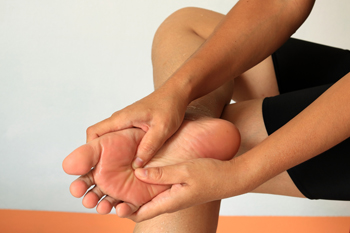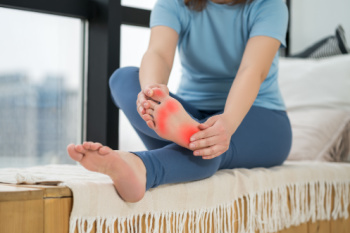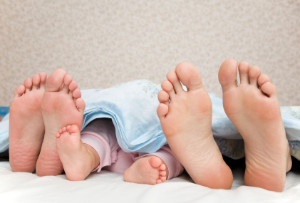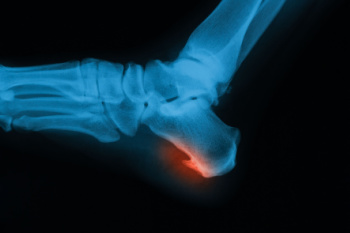
Pain in the ball of the foot can occur for a variety of reasons. Two common causes are stress fractures from excessive exercise or Morton's neuroma, which is thickened tissue around nerves where the toes and metatarsal bones meet. This results in burning pain that is increased by physical activity or from wearing ill-fitting shoes. Other causes of pain in the ball of the foot, often termed metatarsalgia, are bunions. These bony growths at the base of the big toe can alter weight distribution, forcing more pressure onto the ball of the foot. Symptoms typically include a dull ache, sometimes accompanied by burning, tingling sensations, or numbness in the toes that worsens with standing or walking. While supportive footwear and custom orthotics can help redistribute pressure, in severe cases steroid injections or surgery may be necessary for long-term relief. A podiatrist can conduct a thorough exam of the affected foot to form a diagnosis. This will then allow for a personalized treatment plan to address the underlying cause, ensuring effective pain management and restoring mobility. If you are suffering from pain in the ball of the foot, it is suggested that you schedule an appointment with a podiatrist.
Foot Pain
Foot pain can be extremely painful and debilitating. If you have a foot pain, consult with one of our podiatrists from Ocotillo Foot and Ankle Centers. Our doctors will assess your condition and provide you with quality foot and ankle treatment.
Causes
Foot pain is a very broad condition that could be caused by one or more ailments. The most common include:
- Bunions
- Hammertoes
- Plantar Fasciitis
- Bone Spurs
- Corns
- Tarsal Tunnel Syndrome
- Ingrown Toenails
- Arthritis (such as Gout, Rheumatoid, and Osteoarthritis)
- Flat Feet
- Injury (from stress fractures, broken toe, foot, ankle, Achilles tendon ruptures, and sprains)
- And more
Diagnosis
To figure out the cause of foot pain, podiatrists utilize several different methods. This can range from simple visual inspections and sensation tests to X-rays and MRI scans. Prior medical history, family medical history, and any recent physical traumatic events will all be taken into consideration for a proper diagnosis.
Treatment
Treatment depends upon the cause of the foot pain. Whether it is resting, staying off the foot, or having surgery; podiatrists have a number of treatment options available for foot pain.
If you have any questions, please feel free to contact our offices located in Chandler, and Phoenix, AZ . We offer the newest diagnostic and treatment technologies for all your foot care needs.
 Plantar fasciitis, a leading cause of heel pain, occurs when the thick band of tissue that runs along the bottom of your foot and connects the heel bone to the toes becomes inflamed. A large number of plantar fasciitis patients experience persistent heel pain. Treatment for this condition often goes beyond rest, and pain relief measures to include strength exercises specifically designed to alleviate stubborn heel pain. These exercises aim to strengthen the muscles surrounding the foot and ankle, improving support for the plantar fascia and reducing the strain on it. A podiatrist may recommend targeted exercises not only to help relieve the immediate discomfort in the heels but also to prevent future episodes of pain. Incorporating these strength exercises into a comprehensive treatment plan means patients are addressing the root causes of plantar fasciitis. If you experience persistent heel pain from plantar fasciitis, it is suggested that you consult a podiatrist for a personalized treatment plan, which may include performing specific stretches.
Plantar fasciitis, a leading cause of heel pain, occurs when the thick band of tissue that runs along the bottom of your foot and connects the heel bone to the toes becomes inflamed. A large number of plantar fasciitis patients experience persistent heel pain. Treatment for this condition often goes beyond rest, and pain relief measures to include strength exercises specifically designed to alleviate stubborn heel pain. These exercises aim to strengthen the muscles surrounding the foot and ankle, improving support for the plantar fascia and reducing the strain on it. A podiatrist may recommend targeted exercises not only to help relieve the immediate discomfort in the heels but also to prevent future episodes of pain. Incorporating these strength exercises into a comprehensive treatment plan means patients are addressing the root causes of plantar fasciitis. If you experience persistent heel pain from plantar fasciitis, it is suggested that you consult a podiatrist for a personalized treatment plan, which may include performing specific stretches.
Many people suffer from bouts of heel pain. For more information, contact one of our podiatrists of Ocotillo Foot and Ankle Centers. Our doctors can provide the care you need to keep you pain-free and on your feet.
Causes of Heel Pain
Heel pain is often associated with plantar fasciitis. The plantar fascia is a band of tissues that extends along the bottom of the foot. A rip or tear in this ligament can cause inflammation of the tissue.
Achilles tendonitis is another cause of heel pain. Inflammation of the Achilles tendon will cause pain from fractures and muscle tearing. Lack of flexibility is also another symptom.
Heel spurs are another cause of pain. When the tissues of the plantar fascia undergo a great deal of stress, it can lead to ligament separation from the heel bone, causing heel spurs.
Why Might Heel Pain Occur?
- Wearing ill-fitting shoes
- Wearing non-supportive shoes
- Weight change
- Excessive running
Treatments
Heel pain should be treated as soon as possible for immediate results. Keeping your feet in a stress-free environment will help. If you suffer from Achilles tendonitis or plantar fasciitis, applying ice will reduce the swelling. Stretching before an exercise like running will help the muscles. Using all these tips will help make heel pain a condition of the past.
If you have any questions please contact our offices located in Chandler, and Phoenix, AZ . We offer the newest diagnostic and treatment technologies for all your foot and ankle needs.
 Children's foot and heel pain, or CFHP, encompasses a variety of conditions that can impact children’s ability to engage in activities and sports without discomfort. One common cause of CFHP is Sever's disease, a condition that results from inflammation of the growth plate in the heel. Sever’s disease is often seen in active children undergoing growth spurts. Additionally, flat feet or overpronation can strain the foot's muscles and ligaments, causing pain. Improper footwear, intense physical activity, and obesity may also contribute to the development of CFHP. Symptoms typically include pain in the foot or heel, particularly during or after physical activities, and might be accompanied by swelling or redness. Addressing CFHP involves a combination of rest, wearing appropriate footwear, and sometimes orthotic devices to support the foot's structure. Early diagnosis and treatment are important to prevent chronic problems and ensure that children can participate in their favorite activities without pain. If your child is suffering with foot or heel pain, it is suggested that you schedule an appointment with a podiatrist today.
Children's foot and heel pain, or CFHP, encompasses a variety of conditions that can impact children’s ability to engage in activities and sports without discomfort. One common cause of CFHP is Sever's disease, a condition that results from inflammation of the growth plate in the heel. Sever’s disease is often seen in active children undergoing growth spurts. Additionally, flat feet or overpronation can strain the foot's muscles and ligaments, causing pain. Improper footwear, intense physical activity, and obesity may also contribute to the development of CFHP. Symptoms typically include pain in the foot or heel, particularly during or after physical activities, and might be accompanied by swelling or redness. Addressing CFHP involves a combination of rest, wearing appropriate footwear, and sometimes orthotic devices to support the foot's structure. Early diagnosis and treatment are important to prevent chronic problems and ensure that children can participate in their favorite activities without pain. If your child is suffering with foot or heel pain, it is suggested that you schedule an appointment with a podiatrist today.
The health of a child’s feet is vital to their overall well-being. If you have any questions regarding foot health, contact one of our podiatrists of Ocotillo Foot and Ankle Centers. Our doctors can provide the care you need to keep you pain-free and on your feet.
Tips for Keeping Children's Feet Healthy
- Make sure their shoes fit properly
- Look for any signs of in-toeing or out-toeing
- Check to see if they have Clubfoot (condition that affects your child’s foot and ankle, twisting the heel and toes inward) which is one of the most common nonmajor birth defects.
- Lightly cover your baby’s feet (Tight covers may keep your baby from moving their feet freely, and could prevent normal development)
- Allow your toddler to go shoeless (Shoes can be restricting for a young child’s foot)
- Cut toenails straight across to avoid ingrown toenails
- Keep your child’s foot clean and dry
- Cover cuts and scrapes. Wash any scratches with soap and water and cover them with a bandage until they’ve healed.
If you have any questions, please feel free to contact our offices located in Chandler, and Phoenix, AZ . We offer the newest diagnostic and treatment technologies for all your foot care needs.

Cuboid syndrome, also known as cuboid subluxation or lateral plantar neuritis, is a condition where the cuboid bone in the outer midfoot becomes displaced. This displacement can occur due to trauma, overuse, or sudden twisting of the foot. Symptoms typically include pain and tenderness on the outer side of the foot, especially during weight-bearing activities like walking or running. Patients may also experience some difficulty moving the foot sideways. Diagnosis of cuboid syndrome involves a physical examination by a podiatrist, often including specific maneuvers to reproduce the pain and assess foot alignment. X-rays or other imaging studies may be ordered to rule out other potential causes of foot pain. Treatment is typically conservative, including rest, taping, or bracing to stabilize the foot, and exercises to strengthen the surrounding muscles. In some cases, manipulation or mobilization techniques performed by a podiatrist may be beneficial. If you have outer midfoot pain, it is suggested that you make an appointment with a podiatrist.
Cuboid syndrome, also known as cuboid subluxation, occurs when the joints and ligaments near the cuboid bone in the foot become torn. If you have cuboid syndrome, consult with one of our podiatrists from Ocotillo Foot and Ankle Centers. Our doctors will assess your condition and provide you with quality foot and ankle treatment.
Cuboid syndrome is a common cause of lateral foot pain, which is pain on the outside of the foot. The condition may happen suddenly due to an ankle sprain, or it may develop slowly overtime from repetitive tension through the bone and surrounding structures.
Causes
The most common causes of cuboid syndrome include:
- Injury – The most common cause of this ailment is an ankle sprain.
- Repetitive Strain – Tension placed through the peroneus longus muscle from repetitive activities such as jumping and running may cause excessive traction on the bone causing it to sublux.
- Altered Foot Biomechanics – Most people suffering from cuboid subluxation have flat feet.
Symptoms
A common symptom of cuboid syndrome is pain along the outside of the foot which can be felt in the ankle and toes. This pain may create walking difficulties and may cause those with the condition to walk with a limp.
Diagnosis
Diagnosis of cuboid syndrome is often difficult, and it is often misdiagnosed. X-rays, MRIs and CT scans often fail to properly show the cuboid subluxation. Although there isn’t a specific test used to diagnose cuboid syndrome, your podiatrist will usually check if pain is felt while pressing firmly on the cuboid bone of your foot.
Treatment
Just as the range of causes varies widely, so do treatments. Some more common treatments are ice therapy, rest, exercise, taping, and orthotics.
If you have any questions, please feel free to contact our offices located in Chandler, and Phoenix, AZ . We offer the newest diagnostic and treatment technologies for all your foot care needs.



